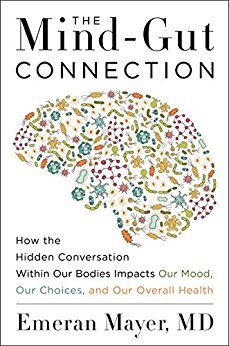More on this book
Community
Kindle Notes & Highlights
by
Emeran Mayer
Your gut has capabilities that surpass all your other organs and even rival your brain. It has its own nervous system, known in scientific literature as the enteric nervous system, or ENS, and often referred to in the media as the “second brain.” This second brain is made up of 50-100 million nerve cells, as many as are contained in your spinal cord.
The immune cells residing in your gut make up the largest component of your body’s immune system; in other words, there are more immune cells living in the wall of your gut than circulating in the blood or residing in your bone marrow.
The lining of your gut is studded with a huge number of endocrine cells, specialized cells that contain up to twenty different types of hormones that can be released into the bloodstream if called upon.
The gut is also the largest storage facility for serotonin in our body. Ninety-five percent of the body’s serotonin is stored in these warehouses. Serotonin is a signaling molecule that plays a crucial role within the gut-brain axis: It is not only essential for normal intestinal functions, such as the coordinated contractions that move food through our digestive system, but it also plays a crucial role in such vital functions as sleep, appetite, pain sensitivity, mood, and overall well-being.
The gut is connected to the brain through thick nerve cables that can transfer information in both directions and through communication channels that use the bloodstream: hormones and inflammatory signaling molecules produced by the gut signaling up to the brain, and hormones produced by the brain signaling down to the various cells in the gut, such as the smooth muscle, the nerves, and the immune cells, changing their functions.
your gut microbes are in a prime position to influence your emotions, by generating and modulating signals the gut sends back to the brain. Thus, what starts as an emotion in the brain influences your gut and the signals generated by your microbes, and these signals in turn communicate back to the brain, reinforcing and sometimes even prolonging the emotional state.
Gut microbiota have also been linked to depression, which is the second leading cause of disability in the United States.
Ninety percent of the signals conveyed through the vagus nerve travel from the gut to the brain, while just 10 percent of the traffic runs in the opposite direction, from the brain to the gut. In fact, the gut can handle most of its activities without any interference from the brain, while the brain seems to depend greatly on vital information from the gut.
It has recently been shown that certain gut microbes can stimulate the production of serotonin in these cells, altering serotonin levels in the gut and profoundly influencing the availability of this gut-brain signal to modulate our emotions, pain sensitivity, and well-being.
gut reactions to specific emotions—positive and negative ones—may dramatically alter the mix of metabolites that gut microbes produce from the food—in other words, they’ll heavily edit the molecular signals our gut microbes send to the rest of our body.
There are some 8 million microbial genes in the gut—400 times more than in the human genome. Even more astonishing, we humans differ very little from each other genetically, sharing more than 90 percent of our genes, but the assortment of microbial genes in our guts differs dramatically, and only 5 percent of them are shared between any two individuals.
I strongly feel that it is the engagement of the gut, and its microbiome, that plays a major role in determining the intensity, duration, and uniqueness of our emotional feelings.
All this means that when you are born into Western civilization, you acquire a Western microbiome as well. Even if you go vegan today, your gut microbiota will remain that of a typical omnivore, and even if you eat a paleo diet for the rest of your life, your gut microbiota won’t turn into that of a hunter-gatherer. However, the pattern of microbial metabolites you produce depends on which diet you consume.
For example, in contrast to the rather limited range of carbohydrate metabolites—which consist primarily of just a few short-chain fatty acids—your body digests proteins into twenty different building-block molecules, called amino acids, and microbes in the colon ferment these amino acids into a much wider range of metabolites, which can interact with the nervous system.
Since we eat such a diversity of foods, particularly plant foods, and our guts contain such vast numbers of diverse microbial cells, it has been estimated that 40 percent of the metabolites circulating in our bodies are produced not by our own cells and tissues, but instead by our gut microbes.


